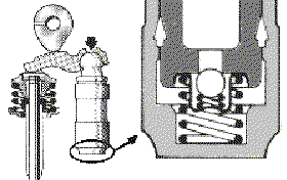|
|
Hydraulic Valve-play Adjustment
Assignment
It automatically compensates and adjusts the valve-play clearance. The amount of effort put into maintaining the engines is reduced, because a regular adjustment of the valves is no longer necessary. Due to the
complete valve-play compensation, the valve-opening is optimised and the engine is quieter.

Function
The cylinder head and the valves are made of different materials. Apart from this, the more a valve is in operation, the longer it becomes, this is because the spring at the end of the valve-shaft pulls the valve back and
because it is abruptly stopped by the valve-disc at the other end. This is why, in engines without the hydraulic valve-play adjustment, a valve-play of 0,1 to 0,4 mm is necessary, which cools the valve, so that the valve-
disc can close securely.
With the hydraulic valve-play adjustment, valve-play is not necessary. In this case, a cylindrical space, from which only a small amount of oil can escape, is filled with oil pressure through a check-valve. This
construction provides a valve-play compensation. With the direct drive, the cylinder can be integrated into the cup-tappets, this however,
increases in moving mass. This
can be avoided if, e.g., the pivot points of the cam followers are hydraulically adjusted (see figure). The valve springs and the cam surfaces are then less subject to strain.
There are sometimes problems with the hydraulic valve-play adjustment. Brief rattling after starting the engine is mostly not that serious. Should the rattling persist, then either the check valve or the variable filling
space is clogged or the oil lead is leaky. In this case, there's nothing that can be adjusted and a so-called engine purge seldom brings the desired success. At least it's (only) the tappet cover(s) and possibly the
camshaft(s) which have to be removed or dismantled to replace the respective parts.
By the way, on the strength of an unfavourable compression test, established mechanics have, after taking the cylinder head apart, been known to have found no real defect. It would have been better if they had first
had a look at the hydraulic lifters, sparing the customer the cost of needless work. 04/09
|
|